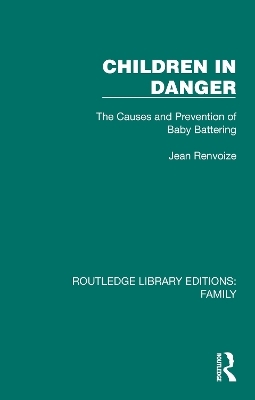
Children in Danger
The Causes and Prevention of Baby Battering
Seiten
2023
Routledge (Verlag)
978-1-032-53217-2 (ISBN)
Routledge (Verlag)
978-1-032-53217-2 (ISBN)
In the early 1970s ‘baby battering’ accounted for an estimated 700 child deaths a year in Britain. First published in 1974, the special virtue of this book was that, apart from being the first fully-researched book on the subject, the author was able to look at baby battering as an outsider, seeing the picture as a whole.
In the early 1970s ‘baby battering’ accounted for an estimated 700 child deaths a year in Britain, while a further 4-5,000 children were seriously injured – all this in spite of the knowledge gained from the research done both in Britain and in the United States. How could such tragedies be prevented? What is known about the parents, the family patterns and social situations that gave rise to baby battering? Extraordinary public interest had been aroused by the appalling case of Maria Colwell, and the problem of baby battering was now receiving the close attention it had long warranted.
Originally published in 1974, Jean Renvoize had spent two years interviewing the battering parents themselves, as well as social workers, doctors, the police and psychiatrists. The special virtue of Children in Danger was that, apart from being the first fully-researched book on the subject, the author was able to look at baby battering as an outsider, seeing the picture as a whole. Her overwhelming impression is that although lip-service was paid to the idea of cooperation between all professionals working in the field, the truth was that too frequently a deep distrust existed between them, particularly between social workers and the police. The result of this distrust was that every year thousands of children fell through the social welfare net with tragic results. Jean Renvoize discusses frankly and impartially the ways the various professions regard each other, and she makes constructive suggestions for the future.
The taped stories of several battering parents, which illustrate how narrow the line is between necessary discipline and near-cruelty, between extreme exasperation and uncontrolled attack, are a moving and illuminating feature of the book. These parents talk not only about their lives and the events which led them towards actions they will never cease regretting, but also about their views of the help that was given them, or the lack of it. They are articulate and self-aware, and here for the first time their story is heard, along with the various professional explanations of why some people cannot stop themselves attacking the children whom they long to love.
In the early 1970s ‘baby battering’ accounted for an estimated 700 child deaths a year in Britain, while a further 4-5,000 children were seriously injured – all this in spite of the knowledge gained from the research done both in Britain and in the United States. How could such tragedies be prevented? What is known about the parents, the family patterns and social situations that gave rise to baby battering? Extraordinary public interest had been aroused by the appalling case of Maria Colwell, and the problem of baby battering was now receiving the close attention it had long warranted.
Originally published in 1974, Jean Renvoize had spent two years interviewing the battering parents themselves, as well as social workers, doctors, the police and psychiatrists. The special virtue of Children in Danger was that, apart from being the first fully-researched book on the subject, the author was able to look at baby battering as an outsider, seeing the picture as a whole. Her overwhelming impression is that although lip-service was paid to the idea of cooperation between all professionals working in the field, the truth was that too frequently a deep distrust existed between them, particularly between social workers and the police. The result of this distrust was that every year thousands of children fell through the social welfare net with tragic results. Jean Renvoize discusses frankly and impartially the ways the various professions regard each other, and she makes constructive suggestions for the future.
The taped stories of several battering parents, which illustrate how narrow the line is between necessary discipline and near-cruelty, between extreme exasperation and uncontrolled attack, are a moving and illuminating feature of the book. These parents talk not only about their lives and the events which led them towards actions they will never cease regretting, but also about their views of the help that was given them, or the lack of it. They are articulate and self-aware, and here for the first time their story is heard, along with the various professional explanations of why some people cannot stop themselves attacking the children whom they long to love.
Jean Renvoize
Acknowledgments. Introduction. 1. A Mother’s Story 2. What is Baby Battering? 3. The Violent End of the Spectrum 4. The Social Worker 5. The Social Worker and the NSPCC 6. The Police 7. The Medical Point of View 8. The Parents 9. What Can be Done to Help? Bibliography.
| Erscheinungsdatum | 11.08.2023 |
|---|---|
| Reihe/Serie | Routledge Library Editions: Family |
| Verlagsort | London |
| Sprache | englisch |
| Maße | 138 x 216 mm |
| Gewicht | 540 g |
| Themenwelt | Sachbuch/Ratgeber ► Gesundheit / Leben / Psychologie |
| Studium ► Querschnittsbereiche ► Prävention / Gesundheitsförderung | |
| Sozialwissenschaften ► Pädagogik ► Sozialpädagogik | |
| Sozialwissenschaften ► Soziologie | |
| ISBN-10 | 1-032-53217-3 / 1032532173 |
| ISBN-13 | 978-1-032-53217-2 / 9781032532172 |
| Zustand | Neuware |
| Informationen gemäß Produktsicherheitsverordnung (GPSR) | |
| Haben Sie eine Frage zum Produkt? |
Mehr entdecken
aus dem Bereich
aus dem Bereich
das Manual zur psychologischen Gesundheitsförderung
Buch | Hardcover (2023)
Springer Berlin (Verlag)
39,99 €
Wissenschaftlich basierte Empfehlungen, Tipps und Ernährungspläne für …
Buch (2022)
Thieme (Verlag)
51,00 €


